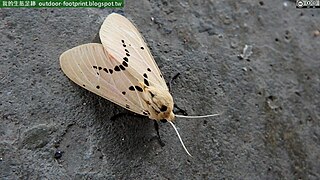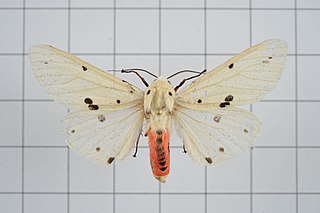
The buff ermine is a moth of the family Erebidae. It is sometimes placed in the genus Spilosoma. The species was first described by Johann Siegfried Hufnagel in 1766. It is found throughout the temperate belt of the Palearctic region south to northern Turkey, Georgia, Kazakhstan, southern Siberia, eastern Mongolia, Amur Region, China, Korea and Japan.

The Spilosomina are a subtribe of tiger moths in the tribe Arctiini, which is part of the family Erebidae.

Spilarctia is a genus of moths in the family Erebidae. The genus was erected by Arthur Gardiner Butler in 1875.
Spilarctia javana is a moth of the family Erebidae. It was described by Walter Rothschild in 1910. It is found on Java.
Spilarctia whiteheadi is a moth of the family Erebidae. It was described by Walter Rothschild in 1910. It is found on Luzon in the Philippines.

Spilarctia subtestacea is a moth in the family Erebidae. It was described by Walter Rothschild in 1910. It is found in Taiwan and Korea.
Spilarctia borneensis is a moth in the family Erebidae. It was described by Walter Rothschild in 1910. It is found on Borneo.
Spilarctia casigneta is a moth in the family Erebidae. It was described by Walter Rothschild in 1910. It is found in northern Pakistan, the Himalayas, Nepal and Bhutan.

Spilarctia postrubida is a moth in the family Erebidae. It was described by Alfred Ernest Wileman in 1910. It is found in Taiwan, Japan's Ryukyu Islands and the Chinese provinces of Guangdong and Hainan.
Spilarctia seriatopunctata is a moth in the family Erebidae. It was described by Motschulsky in 1861. It is found in Russia, China, Korea and Japan.
Spilarctia styx is a moth in the family Erebidae. It was described by George Thomas Bethune-Baker in 1910. It is found in Papua, Indonesia.
Spilarctia hosei is a moth in the family Erebidae. It was described by Walter Rothschild in 1910. It is found on Borneo. The habitat consists of lowland forests.

Spilarctia alba is a moth in the family Erebidae. It was described by Otto Vasilievich Bremer and William Grey in 1853. It is found in China, Taiwan and Korea.

Spilarctia contaminata is a moth in the family Erebidae. It was described by Alfred Ernest Wileman in 1910. It is found in Taiwan.
Spilarctia dohertyi is a moth in the family Erebidae. It was described by Walter Rothschild in 1910. It is found on Sulawesi in Indonesia.
Spilarctia irregularis is a moth in the family Erebidae. It was described by Walter Rothschild in 1910. It is found in the Chinese provinces of Hubei, Sichuan, Yunnan, Henan, Hunan and Shaanxi.
Spilarctia owgarra is a moth in the family Erebidae. It was described by George Thomas Bethune-Baker in 1908. It is found in New Guinea. The habitat consists of mountainous areas.
Spilarctia vandepolli is a moth in the family Erebidae. It was described by Walter Rothschild in 1910. It is found in Sundaland. The habitat consists of lowland rain forests.
Spilarctia continentalis is a moth in the family Erebidae. It was described by Walter Rothschild in 1910. It is found in Malaysia.





